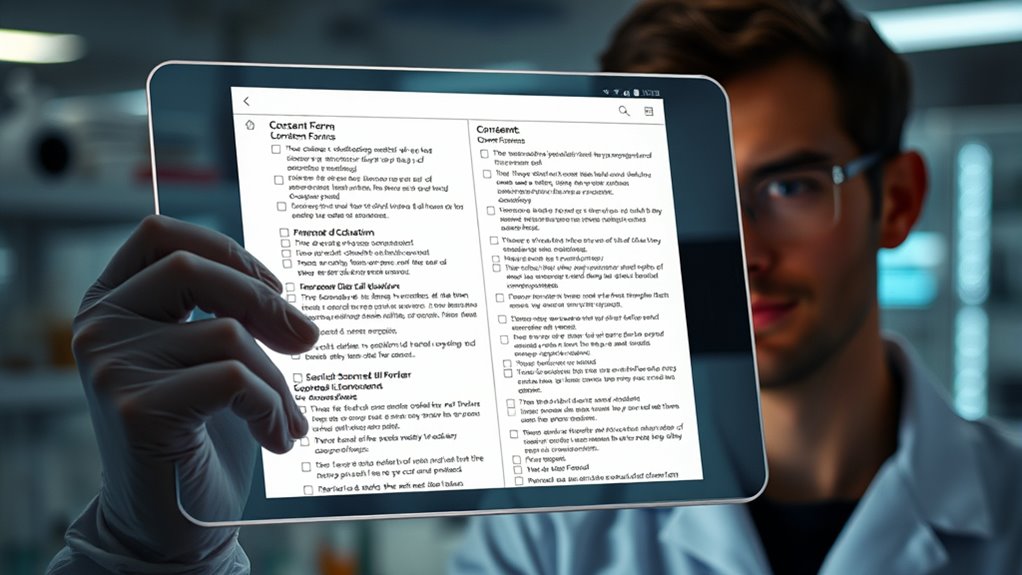When working with prototypes or MVPs that may only mimic functionality, you need to be transparent about their limitations to users. Clearly define what features are real and which are simulated, and communicate this upfront to avoid misleading participants. Obtaining informed consent requires explaining the prototype’s purpose honestly, emphasizing that it may not reflect the final product. Continuing with ethical practices guarantees trust and integrity, and you’ll discover key strategies for maintaining honesty throughout your testing process.
Key Takeaways
- Clearly communicate the prototype’s limitations and purpose to ensure participants understand what is real versus simulated.
- Obtain explicit informed consent, highlighting the prototype’s nature and managing expectations about functionality.
- Maintain transparency about data collection, privacy measures, and how user information will be used.
- Avoid misleading visuals or language that suggest features not yet implemented to prevent false impressions.
- Foster open dialogue, encouraging honest feedback while emphasizing the prototype’s experimental and non-final status.
Defining the Boundaries of a Prototype

How do you determine where a prototype should stop and the real product begin? It starts with clear boundary setting. You must define what aspects of the user experience are simulated and which are fully functional. This clarity helps manage participant awareness—ensuring users understand they’re interacting with a prototype, not a finished product. Setting these boundaries prevents misunderstandings and misinterpretations about the product’s capabilities. Be transparent about what’s real and what’s simulated, and communicate this consistently. This approach fosters trust and keeps users informed about their role in the testing process. By establishing these limits early, you protect both your team’s integrity and your participants’ rights, avoiding ethical pitfalls that come with blurred lines between prototypes and actual products. Additionally, considering the design process ensures that the prototype effectively tests the intended features without misleading users about the product’s maturity.
The Role of Transparency in User Engagement

Transparency plays a crucial role in building trust and encouraging genuine user engagement with prototypes. When you’re open about your intentions, users feel more comfortable sharing honest feedback. Address confidentiality concerns upfront, clarifying how their data will be used and protected. Recognizing cultural sensitivities is equally important; you should respect different perspectives and avoid assumptions that could alienate or offend. Being transparent helps manage expectations and reduces the risk of misunderstandings. It signals that you value honesty and respect user rights throughout the prototyping process. This openness fosters a collaborative environment, making users more willing to participate sincerely. Additionally, clear cookie management guidelines demonstrate your commitment to privacy and foster user confidence. Ultimately, transparency isn’t just ethical—it’s essential for meaningful engagement and for gathering authentic insights that guide responsible product development.
Recognizing the Illusory Nature of Early-Stage Products

Have you ever mistaken an early-stage prototype for a finished product? It’s easy to fall into that trap because illusionary boundaries can blur what users perceive as complete. Early prototypes often create an illusion of functionality and stability that isn’t real. Recognizing this is essential for perception management; you need to understand that what users see isn’t the final version. These prototypes are tools to gather feedback, not finished products. By acknowledging their limitations, you prevent misguided assumptions about user acceptance or product readiness. This awareness helps you avoid overpromising and keeps expectations aligned with reality. Ultimately, understanding the illusionary nature of early-stage products ensures ethical transparency and fosters trust—both critical when dealing with perceptions shaped by incomplete or evolving prototypes. Additionally, being mindful of the perception of organization in your prototypes can influence user expectations and feedback.
Ethical Responsibilities in User Testing Scenarios

When conducting user tests, it’s essential to communicate clearly about what participants can expect. Managing their expectations helps build trust and guarantees they understand the purpose of the testing. Being transparent shows respect for their time and input, reinforcing ethical responsibility. Providing detailed information about the testing process ensures participants are fully informed about what their involvement entails.
Transparent Communication Importance
Why is it crucial to communicate openly with users during testing? Transparent communication ensures your user-centric design truly reflects user needs and builds trust. When you’re upfront about testing purposes, participants feel respected and more willing to share honest feedback. This honesty aligns with stakeholder accountability, demonstrating your commitment to ethical practices. Clear explanations prevent misunderstandings about the scope and risks involved, reducing potential harm. Being transparent also fosters a collaborative environment, encouraging users to engage genuinely. As a result, your prototypes become more effective and ethically sound. Additionally, understanding anime culture and storytelling can help create more relatable and engaging prototypes. Ultimately, open communication reinforces your responsibility to treat participants ethically, ensuring that their rights and expectations are prioritized throughout the testing process.
Managing Participant Expectations
Managing participant expectations is a crucial aspect of ethical user testing because it helps guarantee that participants understand what the process involves and what they can realistically contribute. Be cautious of manipulation tactics and deception strategies that might be used to influence participants’ perceptions or behavior. Avoid misleading language or omitting details to create false impressions about the test’s purpose or the product’s capabilities. Clearly outline what participants should expect, including the scope of testing and their role. By setting transparent boundaries, you respect their autonomy and reduce the risk of distress or disillusionment later. Ethical management of expectations fosters trust, encourages honest feedback, and upholds your responsibility to treat participants with integrity throughout the testing process. Additionally, understanding expiration and spoilage indicators can guide how you present information about the longevity or limitations of a product, ensuring participants are not misled about its safety or effectiveness.
Informed Consent: Clarity and Comprehension Challenges

Have you ever wondered if participants truly understand what they’re consenting to in a research study? Cognitive biases can cloud judgment, leading participants to overlook or misunderstand pivotal details. For example, optimism bias might cause them to assume positive outcomes without fully grasping risks, while the framing of information can subtly influence their decisions. These challenges make clear communication essential but difficult. User deception, whether intentional or accidental, can further obscure understanding, giving participants a false sense of knowledge or control. Ensuring clarity isn’t just about simplifying language; it requires awareness of biases and how they shape perception. Additionally, understanding the 16PF traits can help researchers tailor their explanations to address individual differences in perception and comprehension. Without addressing these comprehension challenges, you risk invalid consent, which compromises both ethical integrity and the validity of your research.
Balancing Innovation With User Rights

As you pursue innovative prototypes, you need to prioritize ethical data collection and transparency in testing. Users have the right to know how their data is used and to trust that testing isn’t hidden or manipulative. Balancing these concerns with your drive to innovate is essential to build trust and respect user rights. Emphasizing Vetted Content ensures that resources and strategies used in testing adhere to high standards of quality and integrity.
Ethical Data Collection
Balancing innovation with user rights is a critical challenge in ethical data collection. You need to prioritize data privacy while collecting useful information, but consent barriers can hinder this process. Users often hesitate to share data due to concerns about how it’ll be used or mishandled. To address this, you should design clear, straightforward consent processes that inform users without overwhelming them. Respect their autonomy by allowing easy options to opt-in or out, and avoid collecting data beyond what’s necessary for your prototype. Be transparent about your intentions, and ensure that data is securely stored and anonymized where possible. Ultimately, protecting user rights isn’t just ethical; it fosters trust, encouraging more honest participation and sustainable innovation. Incorporating data security measures is essential to maintain confidentiality and uphold user confidence.
Transparency in Testing
Why is transparency in testing crucial for maintaining user trust while pushing innovative boundaries? When you openly communicate testing goals and processes, you foster stronger user engagement and demonstrate respect for their rights. Transparency reassures users that their data is handled responsibly, preserving data integrity and reducing suspicion. If you’re clear about what data you collect and how it’s used, users are more likely to participate willingly and provide honest feedback. This openness also helps you identify potential ethical issues early, preventing harm and building credibility. Additionally, understanding user privacy expectations is vital for aligning your testing practices with ethical standards. Ultimately, balancing transparency with innovation ensures you push boundaries ethically, earning user trust and loyalty. Being transparent isn’t just good practice; it’s essential for creating sustainable, user-centered prototypes that respect individual rights.
Case Studies: When Prototypes Misinform Participants

Prototypes can sometimes mislead participants by suggesting capabilities or outcomes that don’t reflect the final product. Visual deception is a common issue, where the prototype’s appearance implies features or quality that won’t exist later, creating false expectations. This can complicate consent, as participants may agree based on an inaccurate perception of the product’s capabilities. For example, a visual mockup might imply seamless functionality that’s not yet implemented, leading participants to believe they’re testing a fully developed system. These misunderstandings can affect the validity of informed consent, as participants may not realize the prototype’s limitations. Recognizing these risks is essential to ensuring ethical testing practices and transparent communication about what the prototype actually represents.
Developing Ethical Guidelines for MVP Testing

Developing ethical guidelines for MVP testing is essential to guarantee that the process respects participants’ rights and maintains trust. You need to contemplate prototype realism carefully, ensuring your MVP accurately reflects the product without misleading users about its capabilities. Overstating features or creating a deceptive environment can lead to user deception, damaging credibility and violating ethical standards. Clear boundaries must be set to prevent participants from being manipulated or misled about the prototype’s purpose. Guidelines should emphasize transparency about the prototype’s limitations and intentions, even if it’s not a fully functional product. By establishing these principles, you protect participants from harm, uphold integrity, and foster a trustworthy environment for MVP testing. This approach balances innovation with ethical responsibility.
The Impact of Misleading Users on Trust and Reputation

When users discover that a product or feature they tested was misleading, their trust can quickly erode. This trust erosion damages your reputation, making users hesitant to engage with future prototypes or releases. Once trust is broken, it’s hard to rebuild, and negative word-of-mouth can spread rapidly. Misleading users, even unintentionally, suggests a lack of transparency and ethical standards, which can be viewed as a breach of user rights. Over time, this diminishes your credibility and could lead to legal challenges or regulatory scrutiny. Protect your reputation by being honest about what your MVP can do, ensuring that users are fully informed. Maintaining transparency preserves trust, fosters loyalty, and ultimately supports your long-term success.
Strategies for Ethical Communication in Prototyping

To foster ethical communication in prototyping, you need to prioritize honesty and clarity from the outset. Clearly explain the purpose of your prototype and its fidelity level, so users understand what they’re testing. Avoid overstating capabilities or presenting low-fidelity prototypes as fully functional products, which can mislead users and damage trust. Be transparent about data collection and how their feedback influences development, emphasizing respect for their user experience. Use straightforward language to set expectations and foster open dialogue. When users know what to expect, they can provide genuine feedback, making your prototyping process more ethical and effective. Balancing transparency with prototype fidelity helps ensure your communication remains honest, respectful, and focused on building trust.
Frequently Asked Questions
How Can I Ethically Justify Testing a Prototype That Isn’T Fully Functional?
When testing an incomplete prototype, you need to address transparency concerns and respect user autonomy. Clearly explain the prototype’s limitations and that it’s not fully functional, so users understand what they’re experiencing. Obtain informed consent by sharing these details upfront, allowing users to make an informed decision about participation. This honest approach guarantees ethical testing, maintains trust, and respects user rights, even when the prototype isn’t fully developed.
What Legal Liabilities Exist if Users Are Misled During Prototype Testing?
You should be aware that if you mislead users during prototype testing, there are significant legal ramifications. Liability concerns may arise if users believe they’re engaging with a fully functional product when they’re not, leading to potential claims of false advertising or breach of trust. To minimize risks, clearly communicate the prototype’s limitations and purpose, ensuring transparency and reducing your exposure to legal liabilities.
How Do Cultural Differences Influence Perceptions of Informed Consent in Prototyping?
Ironically, in our globalized world, you might assume everyone shares the same view of informed consent. But cross-cultural norms shape consent perceptions, often differently than you’d expect. What’s seen as transparent in one culture could be intrusive in another. You must adapt your approach, respecting these diverse perceptions, or risk alienating users or violating ethical standards. Recognizing these nuances isn’t just good practice—it’s essential for respectful, effective prototyping across borders.
Should Users Be Compensated for Participating in Early-Stage Prototype Testing?
You might wonder if users should be compensated for early prototype testing. Considering user motivation, offering compensation can encourage honest feedback and engagement. However, compensation ethics come into play—it’s essential to avoid coercion or undue influence. You should weigh the value of users’ time and effort against ethical standards, ensuring participation remains voluntary and transparent. Ultimately, fair compensation respects users and fosters trust in your prototyping process.
How Can Companies Rebuild Trust After Ethical Breaches in Prototyping?
You can rebuild trust after ethical breaches by implementing transparency initiatives that openly communicate your actions and improvements. Prioritize ethical training for your team to foster a culture of responsibility and integrity. Show genuine accountability by acknowledging mistakes and demonstrating your commitment to ethical practices. Consistently engaging with users and stakeholders reassures them that their well-being and rights are your top priorities, helping restore confidence in your company’s approach.
Conclusion
As you navigate the blurred lines of prototyping, remember that transparency isn’t just ethical—it’s essential for trust. Sometimes, the very nature of your MVP can unintentionally deceive, reminding you that even well-intentioned testing carries risks. Embrace honesty and clarity, because in this unpredictable landscape, your commitment to ethical communication shapes not just your product’s future, but the trust you build along the way. After all, perception and reality often dance unexpectedly together.









